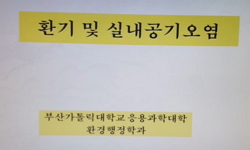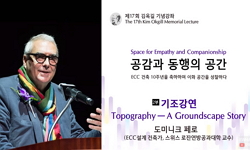목 적: 지하에 위치한 방사선치료 관련시설 내의 실내공기 질은 근무자뿐만 아니라 장기간 치료받는 환자들의 건 강에도 중요하다. 저자들은 근무자들의 빌딩증후군 증상유무의 확인과 함...
http://chineseinput.net/에서 pinyin(병음)방식으로 중국어를 변환할 수 있습니다.
변환된 중국어를 복사하여 사용하시면 됩니다.
- 中文 을 입력하시려면 zhongwen을 입력하시고 space를누르시면됩니다.
- 北京 을 입력하시려면 beijing을 입력하시고 space를 누르시면 됩니다.


지하에 위치한 방사선종양학과에서의 실내공기 질 평가 = Evaluation of Indoor Air Quality in a Department of Radiation Oncology Located Underground
한글로보기https://www.riss.kr/link?id=A82296916
- 저자
- 발행기관
- 학술지명
- 권호사항
-
발행연도
2005
-
작성언어
-
- 주제어
-
KDC
510
-
등재정보
KCI등재후보,SCOPUS
-
자료형태
학술저널
- 발행기관 URL
-
수록면
243-252(10쪽)
-
KCI 피인용횟수
0
- 제공처
-
0
상세조회 -
0
다운로드
부가정보
국문 초록 (Abstract)
목 적: 지하에 위치한 방사선치료 관련시설 내의 실내공기 질은 근무자뿐만 아니라 장기간 치료받는 환자들의 건
강에도 중요하다. 저자들은 근무자들의 빌딩증후군 증상유무의 확인과 함께 실내공기 질과 관련된 여러 인자들을
측정, 분석하여 그 원인을 찾고 해결책을 제시하고자 하였다. 대상 및 방법: 근무자들을 대상으로 자각증상 및 근무환경 인식과 관련된 설문조사를 하였고, 예비조사를 바탕으로 실내공기 질과 관련된 항목들(온·습도, 미세먼지, 이산화탄소, 일산화탄소, 포름알데히드, 총휘발성유기화합물, 라돈)에 대해 근무자들이 주로 머무르는 지역들을 중심으로 일정기간 측정하였다. 아울러 환기(공조) 시스템의 효율 및 주변 환경에 대한 평가를 동시에 진행하였으며, 실외공기와의 비교평가를 위해 1층(실외)에서도 같은 항목들을 측정하였고, 측정 자료들은 국내외 환경관련 기관들의 권고 수치를 기준으로 각각 평가하였다. 결 과: 설문조사에서 근무자들은 악취, 습도, 먼지 등에 대해 불만족을 보였으며, 근골격계 증상, 신경계 증상, 점막 자극 증상 등을 주로 호소하였다. 대부분의 실내공기 질 관련 항목들은 기준치를 넘지 않았으나 총휘발성유기화합물 수치가 기존 미국 사무실 측정 수치에 비해 3∼4배 높게 나왔다. 환기 횟수나 환기량에서는 문제가 없었으나 실외공기 유입구와 실내공기 배출구의 위치 문제로 인해 오염된 공기의 유입 가능성이 있었다. 총휘발성유기화합
물을 배출할 수 있는 현상액과 같은 화학물질의 관리에 주의가 필요했으며, 오염된 공기의 재유입 문제를 해결하
기 위해 환기 시스템의 위치조정이 시급한 상황이었다. 결 론: 저자들은 실내공기 질에 대한 평가에서 일부 화학물질 및 부적절한 환기 시스템으로 인해 근무자들이 주관적인 증상을 호소할 수 있음을 확인하였다. 지하 공간에서 장시간 거주하는 근무자들의 근무여건 개선과 함께 면역저하를 동반한 환자들의 건강관리를 위해 실내공기 질에 대한 평가는 반드시 필요하며, 그 자료를 바탕으로 향후 방사선종양학과의 설계나 기존 시설의 환경개선 등에 적극적으로 이용해야 하겠다.
다국어 초록 (Multilingual Abstract)
Purpose: Indoor air quality (IAQ) in the radiation treatment center which is generally located underground is important to the health of hospital workers and patients treated over a long period of time. This study was conducted to measure and analyz...
Purpose: Indoor air quality (IAQ) in the radiation treatment center which is generally located underground is
important to the health of hospital workers and patients treated over a long period of time. This study was
conducted to measure and analyze the factors related to IAQ and subjective symptoms of sick building
syndrome, and to establish the causes influencing IAQ and find a solution to the problems. Methods and Materials: Self administrated questionnaire was conducted to check the workers’ symptoms and understanding of the work environment. Based on a preliminary investigation, the factors related to IAQ such as temperature, humidity, fine particulate. carbon dioxide, carbon monoxide, formaldehyde, total volatile organic compounds (TVOC), and radon gas were selected and measured for a certain period of time in specific sites where hospital workers stay long in a day. And we also evaluated the surrounding environment and the efficiency of the ventilating system simultaneously, and measured the same factors at the first floor (outdoor) to compare with outdoor air quality. All collected data were assessed by the recommended standard for IAQ of the domestic and international environmental organizations. Results: Hospital workers were discontented with foul odors, humidity and particulate. They complained symptoms related to musculo-skeletal system, neurologic system, and mucosal-irritatation. Most of the factors were not greater than the recommended standard, but the level of TVOC was third or fourth times as much as the measuring level of some offices in the United States. The frequency and the amount of the ventilating system were adequate, however, the problem arising in the position of outdoor-air inlets and indoor-air outlets involved a risk of the indraft of contaminated air. A careful attention was a requirement in handling and keeping chemical substances including a developing solution which has a risk of TVOC emissions, and repositioning the ventilating system was needed to solve the contaminated-air circulation immediately. Conclusion: We verified that some IAQ-related factors and inadequate ventilating system could cause
subjective symptoms in hospital workers. The evaluation of IAQ was surely needed to improve the underground
working environments for hospital workers and patients. On the basis of these data, from now on, we should
actively engage in designs of the department of radiation oncology or improvement in environments of the
existing facilities.
참고문헌 (Reference)
1 "distributions of aerosol and elemental concentrations in personal indoor and outdoor air samples in a Southern California community" 227-250, jexpoanalenvironepidemio1993
2 "The National Instiute for Occupational Safety and Health indoor environmental evaluation experience, part two: symptom prevalence" 11 : 540-545, 1996
3 "International conference on indoor environment quality in hospitals.Prague 10-11 October 2002" 11 : 115-116, 2003
4 "Influence of indoor air quality and personal factors on the sick building syndrome(SBS)in Swedish geriatric hospitals" 52 : 170-176, 1995
5 "Indoor environmental quality in six commercial office building in the midwest United States" 16 : 1065-1077, 2001
6 "Indoor climate,air pollution,and human comfort" 1 : 63-81, 1991
7 "Indoor air quality:a psychosocial perspective" 32 : 425-428, 1990
8 "Indoor air quality, ventilation and health symptoms in schools: an analysis of existing information" 13 : 53-64, 2003
9 "Health risk assessment of exposure to indoor air pollutants in office building" 14 : 251-263, 2004
10 "Environmental air pollution in an intensive care unit for nephrology and dialysis" 13 : 433-436, 2000
1 "distributions of aerosol and elemental concentrations in personal indoor and outdoor air samples in a Southern California community" 227-250, jexpoanalenvironepidemio1993
2 "The National Instiute for Occupational Safety and Health indoor environmental evaluation experience, part two: symptom prevalence" 11 : 540-545, 1996
3 "International conference on indoor environment quality in hospitals.Prague 10-11 October 2002" 11 : 115-116, 2003
4 "Influence of indoor air quality and personal factors on the sick building syndrome(SBS)in Swedish geriatric hospitals" 52 : 170-176, 1995
5 "Indoor environmental quality in six commercial office building in the midwest United States" 16 : 1065-1077, 2001
6 "Indoor climate,air pollution,and human comfort" 1 : 63-81, 1991
7 "Indoor air quality:a psychosocial perspective" 32 : 425-428, 1990
8 "Indoor air quality, ventilation and health symptoms in schools: an analysis of existing information" 13 : 53-64, 2003
9 "Health risk assessment of exposure to indoor air pollutants in office building" 14 : 251-263, 2004
10 "Environmental air pollution in an intensive care unit for nephrology and dialysis" 13 : 433-436, 2000
11 "Effect of air humidification on the sick building syndrome and perceived indoor air quality in hospitals:a four month longitudinal study" 51 : 683-688, 1994
12 "Baseline indoor air quality measurement collected from 136 metropolitan New York region commercial office building between 1997- 1999" 63 : 354-360, 2002
13 "Assessment of human inhalation exposure to polycyclic aromatic hydrocarbons" 6 : 439-447, 1996
14 "A survey of indoor and outdoor radon concentrations by alpha track detector in Korea" 28 : 71-76, 2002
15 "A study on the characteristics of indoor air quality in office and subjective symptoms of office workers" 14 : 270-282, 2004
동일학술지(권/호) 다른 논문
-
- 대한방사선종양학회
- 임상욱(Sangwook Lim)
- 2005
- KCI등재후보,SCOPUS
-
근접방사선치료용 다목적 팬톰을 이용한 직장 내 선량분석
- 대한방사선종양학회
- 허현도(Hyun Do Huh)
- 2005
- KCI등재후보,SCOPUS
-
Contralateral Breast Dose Reduction Using a Virtual Wedge
- 대한방사선종양학회
- 여인환(Inhwan Yeo)
- 2005
- KCI등재후보,SCOPUS
-
- 대한방사선종양학회
- Rena Lee(이레나)
- 2005
- KCI등재후보,SCOPUS
분석정보
인용정보 인용지수 설명보기
학술지 이력
| 연월일 | 이력구분 | 이력상세 | 등재구분 |
|---|---|---|---|
| 2024 | 평가예정 | 해외DB학술지평가 신청대상 (해외등재 학술지 평가) | |
| 2021-01-01 | 평가 | 등재학술지 선정 (해외등재 학술지 평가) |  |
| 2020-12-01 | 평가 | 등재후보로 하락 (해외등재 학술지 평가) |  |
| 2015-01-01 | 평가 | SCOPUS 등재 (기타) |  |
| 2013-01-01 | 평가 | 등재후보 1차 FAIL (등재후보1차) |  |
| 2012-04-01 | 평가 | 등재후보로 하락 (기타) |  |
| 2012-01-01 | 평가 | 등재후보학술지 유지 (기타) |  |
| 2011-12-30 | 학회명변경 | 영문명 : The Korean Society For Therapeutic Radiology And Oncology -> The Korean Society for Radiation Oncology |  |
| 2011-08-22 | 학술지명변경 | 한글명 : 대한방사선종양학회지 -> Radiation oncology journal 외국어명 : The Journal of the Korean Society for Therapeutic Radiology and Oncology -> Radiation oncology journal |  |
| 2009-01-01 | 평가 | 등재 1차 FAIL (등재유지) |  |
| 2006-01-01 | 평가 | 등재학술지 선정 (등재후보2차) |  |
| 2005-01-01 | 평가 | 등재후보 1차 PASS (등재후보1차) |  |
| 2004-01-01 | 평가 | 등재후보학술지 유지 (등재후보1차) |  |
| 2002-01-01 | 평가 | 등재후보학술지 선정 (신규평가) |  |
학술지 인용정보
| 기준연도 | WOS-KCI 통합IF(2년) | KCIF(2년) | KCIF(3년) |
|---|---|---|---|
| 2016 | 0.31 | 0.31 | 0.25 |
| KCIF(4년) | KCIF(5년) | 중심성지수(3년) | 즉시성지수 |
| 0.23 | 0.22 | 0.864 | 0.05 |




 ScienceON
ScienceON 스콜라
스콜라






